
 |
Tea Clipper |
 |
| from TeaAntiques.com | ||
| Edition Sixty Four |
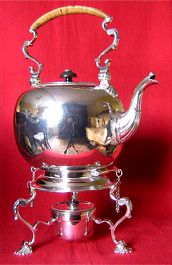 A
very desirable and high quality silver 'globular' shaped tea kettle in the style
of a George I tea kettle, c1740, this particular tea kettle dating from 1905, is
of a good large size and is of heavy gauge silver and beautifully made.
A
very desirable and high quality silver 'globular' shaped tea kettle in the style
of a George I tea kettle, c1740, this particular tea kettle dating from 1905, is
of a good large size and is of heavy gauge silver and beautifully made.
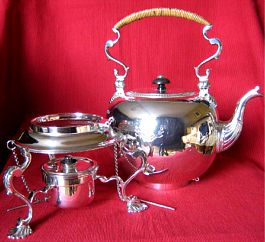 The
tea kettle stands upon a circular foot rim giving it a good solid base. This
raised foot rim fits into the burner stand and is secured by two silver pins on
chains. The pin at the front passes through a spigot on the front of the kettle,
thus allowing it to be tilted forward when the second pin at the back is removed.
Thus a teapot can be filled with ease by just tipping the kettle forward in safety.
With both pins securely in place, the tea kettle can be lifted around safely by
the swing handle, keeping the kettle secured to the burner stand. With both
pins removed, the kettle can be lifted away from the stand, allowing access to the
spirit burner.
The
tea kettle stands upon a circular foot rim giving it a good solid base. This
raised foot rim fits into the burner stand and is secured by two silver pins on
chains. The pin at the front passes through a spigot on the front of the kettle,
thus allowing it to be tilted forward when the second pin at the back is removed.
Thus a teapot can be filled with ease by just tipping the kettle forward in safety.
With both pins securely in place, the tea kettle can be lifted around safely by
the swing handle, keeping the kettle secured to the burner stand. With both
pins removed, the kettle can be lifted away from the stand, allowing access to the
spirit burner.
The handle is of charming swing type, so that it maybe lowered to either side. This attractive swing handle of the tea kettle is of silver, with a wicker handle covering the top portion allowing it to be handled when the kettle is full of hot water. Either side of the top wicker covered top of the handle, the handle is formed of delightful 'S' and 'C' scrolls terminating at the well made swivel joints on the body of the kettle.
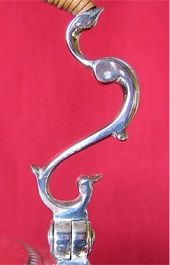
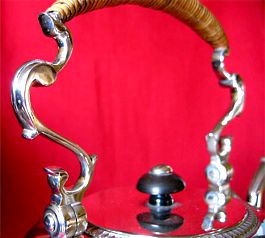
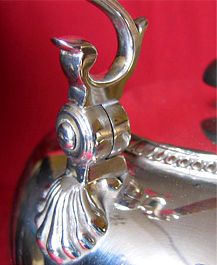
The stand to this beautiful tea kettle is circular in form, with three very attractive 'S' and 'C' scroll shaped legs. Each leg is capped at the top scroll with a leaf which is applied down the back of the scroll-this creating a beautiful decorative feature.
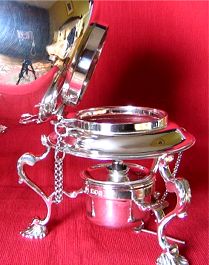
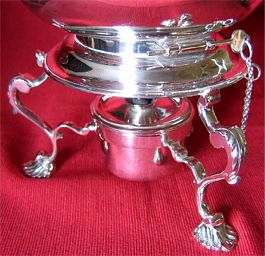
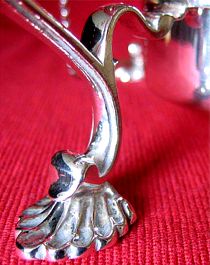
Each of the three legs is terminated on a cast silver shell foot, exquisitely made, giving the stand a very firm footing. The legs are then attached to three scrolling braces to a circular centre support. This support is the housing for the drop-in spirit burner.
The tea kettle and stand is hallmarked throughout, including on the side of the kettle's body, on the lid rim the lid, on the swing handle, on the stand frame, the drop-in burner cup and cover. All hallmarks are very crisp and clear.
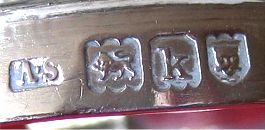
This is certainly the 'Rolls-Royce' of Tea Kettles and would be a delightful addition to the tea table at tea time. It is a faithful copy of a George I style Tea Kettle, but at a fraction of the price.
More details of this item and other tea related antiques can be found by visiting my web site at www.TeaAntiques.com.
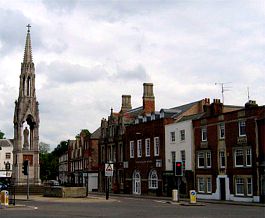 Towards
the extremities of the Norfolk's Northern coast is the Fenland town of Wisbech,
a slightly neglected town in its appearance now, but at the heart of it, one of
the finest sets of Georgian buildings to be seen in England. From walking round
the town it is evident that once it was a flourishing hub of Georgian commerce and
trade. The town is divided by a manmade river, the River Nene, once navigable by
trading ships, but now a sad reflection of its industrial past.
Towards
the extremities of the Norfolk's Northern coast is the Fenland town of Wisbech,
a slightly neglected town in its appearance now, but at the heart of it, one of
the finest sets of Georgian buildings to be seen in England. From walking round
the town it is evident that once it was a flourishing hub of Georgian commerce and
trade. The town is divided by a manmade river, the River Nene, once navigable by
trading ships, but now a sad reflection of its industrial past.
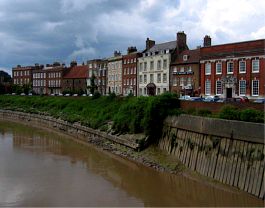 However,
this river does provide a wonderful setting for the Northern brink of the Georgian
development, where there is a very fine street of individually designed Georgian
houses. Peckover House is one of the houses in this delightful set of buildings.
However,
this river does provide a wonderful setting for the Northern brink of the Georgian
development, where there is a very fine street of individually designed Georgian
houses. Peckover House is one of the houses in this delightful set of buildings.
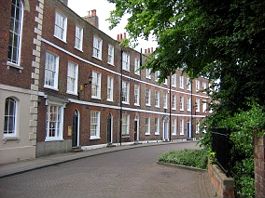
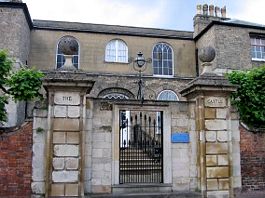
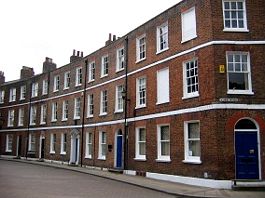
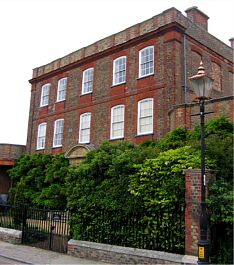
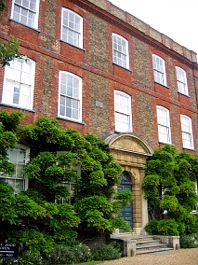 Peckover
House itself is, without doubt, one of the grandest houses within Wisbech and now
in the hands of the National Trust. With its view out over the river, it stands
slightly set back from the road, with a black iron railed little garden. The house
was built c1722, the architect is unknown. It has three principle floors and is
five bays wide. The ground floor front is now covered with large Wisterias, these
must have been planted in this position some time ago to have reached this maturity.
In some respects, the Wisteria detracts from being able to enjoy the architectural
features of the lower floor of the building. A central front door is visible, with
its yellow stone door surround of classical Georgian style. A mixture of coloured
bricks are used to highlight the feature front of the house, with red brick dressing
used around the sash windows.
Peckover
House itself is, without doubt, one of the grandest houses within Wisbech and now
in the hands of the National Trust. With its view out over the river, it stands
slightly set back from the road, with a black iron railed little garden. The house
was built c1722, the architect is unknown. It has three principle floors and is
five bays wide. The ground floor front is now covered with large Wisterias, these
must have been planted in this position some time ago to have reached this maturity.
In some respects, the Wisteria detracts from being able to enjoy the architectural
features of the lower floor of the building. A central front door is visible, with
its yellow stone door surround of classical Georgian style. A mixture of coloured
bricks are used to highlight the feature front of the house, with red brick dressing
used around the sash windows.
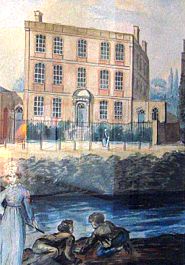 The
early history of the house is rather sketchy, as there are very few records. The
first known owner of the house was Henry Southwell, who bought the house in 1752.
Southwell was an important local figure in Wisbech. He was the Town Bailiff in 1727
and 1755, also the High Sheriff of Cambridgeshire and Huntingtonshire in 1754. His
Father lived in Wisbech Castle and so obviously came from good high society stock.
It was Henry Southwell who was responsible for much of the grand interior of Peckover
House. The house was actually known as Bank House until 1948, when it was changed
to Peckover House.
The
early history of the house is rather sketchy, as there are very few records. The
first known owner of the house was Henry Southwell, who bought the house in 1752.
Southwell was an important local figure in Wisbech. He was the Town Bailiff in 1727
and 1755, also the High Sheriff of Cambridgeshire and Huntingtonshire in 1754. His
Father lived in Wisbech Castle and so obviously came from good high society stock.
It was Henry Southwell who was responsible for much of the grand interior of Peckover
House. The house was actually known as Bank House until 1948, when it was changed
to Peckover House.
It was in 1794, that the house changed hands and was purchased by Jonathan Peckover. The Peckovers were a wealthy family, whose money had come from Banking. Jonathan set up a small grocer's business. However, he soon found himself holdings several of his customers' money for them for safe-keeping. It then went on to develop into a small Bank and from there, he went into partnership with the well established Quaker bankers, Gurneys & Co. of Norwich. Peckover's Bank thrived under his management and was known as the Wisbech and Lincolnshire Bank. The Bank continued to be administered by the Peckovers until Alexander Peckover retired in 1893. From here in 1896, the Bank became amalgamated with nineteen other private banks and were to become what is now Barclays Bank.
The interior of the house is quite unexpectedly grand for a house of this proportion. It has some remarkable carvings and plasterwork that would not look out of place in a grander country house of the period. As a banker, it was important to have somewhere grand in which to entertain and receive his bank clients and Peckover house certainly fits that bill.
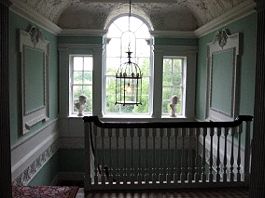
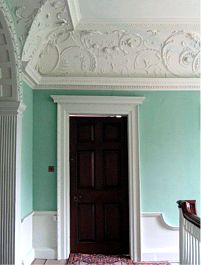
There is a fairly wide Entrance Hall that runs from the front door through to a door which leads out the back into the garden. To the back right an impressive staircase rises up and back on itself to the first floor. The appearance of the Hall remains much as it was in the eighteenth century. The only real later alteration is the addition of a beautiful Venetian style window above the landing of the staircase. With the Hall walls painted a pale blue, with white plasterwork and a black and white stone floor, the Hall offers a light and elegant entrance to the house and offers access to all the principle rooms of the house as well as to stairs leading down to the domestic floor and kitchen.
To the left of the front door is the Dining Room of the house. The walls are panelled and in the centre of the room a circular table with a splayed leg central column support. Around the table a collection of slightly different style early eighteenth century walnut spoon back chairs. This room would have been used for more formal family and guest entertaining, whereas more informal meals were taken in a smaller room behind the Dining Room.
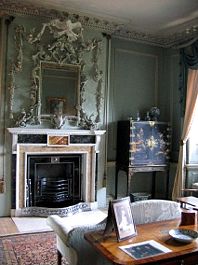 Moving
out of the Dining Room across the hall on the other side of the front of the house
is a beautiful and extremely elegant room known as the Drawing Room. Perfectly proportioned,
the room has an elaborate plaster cornice running round the room. The walls have
rectangular panels, a dado and skirting, all picked out in soft white against
a room colour of soft pale blue. This would be the principle room for entertaining.
Moving
out of the Dining Room across the hall on the other side of the front of the house
is a beautiful and extremely elegant room known as the Drawing Room. Perfectly proportioned,
the room has an elaborate plaster cornice running round the room. The walls have
rectangular panels, a dado and skirting, all picked out in soft white against
a room colour of soft pale blue. This would be the principle room for entertaining.
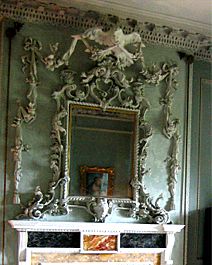 One
of the most striking features of this room, is the ornate carved mirror frame above
the marble fire surround. It is believed that this magnificent carving was carried
out in situ in the 1750's. Carved in very much the Rococo style. It is surmounted
by a carved eagle like bird, it holds the top of the swags of the frame within its
beak. The actual marble fireplace is attractive with various coloured marbles and
this houses a fine polished steel eighteenth century fire grate.
One
of the most striking features of this room, is the ornate carved mirror frame above
the marble fire surround. It is believed that this magnificent carving was carried
out in situ in the 1750's. Carved in very much the Rococo style. It is surmounted
by a carved eagle like bird, it holds the top of the swags of the frame within its
beak. The actual marble fireplace is attractive with various coloured marbles and
this houses a fine polished steel eighteenth century fire grate.
The furniture in this room is of the period and includes a lacquered cabinet on stand, pair of mid-eighteenth century silver tables in the Chinese Chippendale style and camel back settee upholstered in a pale blue damask, c1760. Behind the settee stands a Regency sofa table. This has a top that is veneered in birds-eye maple and would date from c1810. Sat upon the sofa table there are two very fine George III tea caddies. Both caddies are of elongated hexagonal shape, with floral inlay panels on the front and lid, these would date from c1780.
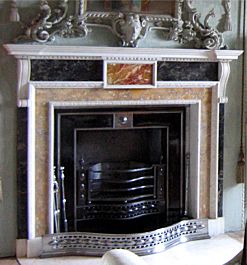
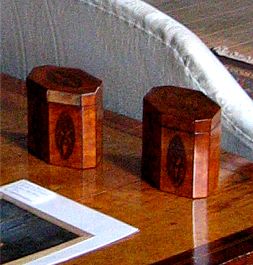
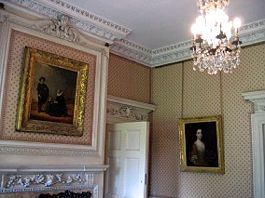 A
door to the left side of the Drawing Room, leads through to the Morning Room at
the back right corner of the house. As with all the other rooms in the house it
has fine plasterwork and is beautifully proportioned. Originally, this was the Library
in the eighteenth century and early part of the nineteenth century. It was made
into a Morning Room around 1877 and the Library now is in a long extension room
on the right-hand side of the house. All the plaster work, fireplace and surround
as well as doors and door surrounds date from the eighteenth century.
A
door to the left side of the Drawing Room, leads through to the Morning Room at
the back right corner of the house. As with all the other rooms in the house it
has fine plasterwork and is beautifully proportioned. Originally, this was the Library
in the eighteenth century and early part of the nineteenth century. It was made
into a Morning Room around 1877 and the Library now is in a long extension room
on the right-hand side of the house. All the plaster work, fireplace and surround
as well as doors and door surrounds date from the eighteenth century.
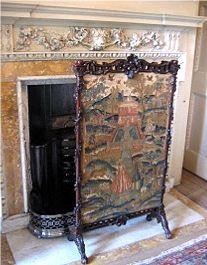
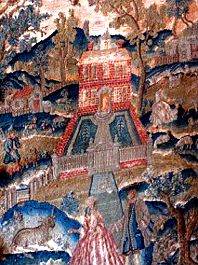
There is an impressive fire screen in front of the fireplace. It has a delightful carved rectangular mahogany frame and in it a charming embroidery showing a house, formal gardens and people. This embroidery was the work of Jane Jessup who was the mother of Jonathan Peckover. It was embroidered c1750 and even today, the colours are remarkably well preserved.
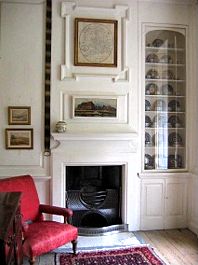
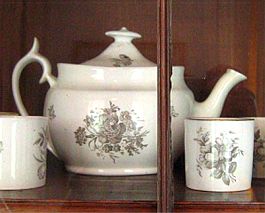 On
the opposite side of the Hall to the Morning Room, at the back of the house is a
rather small room known as the Breakfast Room. This was used as the name suggest
for family breakfasts, also for more informal family meals. It is room which has
a fine prospect out over the garden. At one end of the room is a teaset in a glass
display cabinet, the pattern of which is called 'Royal Lily'.
On
the opposite side of the Hall to the Morning Room, at the back of the house is a
rather small room known as the Breakfast Room. This was used as the name suggest
for family breakfasts, also for more informal family meals. It is room which has
a fine prospect out over the garden. At one end of the room is a teaset in a glass
display cabinet, the pattern of which is called 'Royal Lily'.
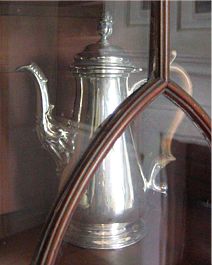 In
a Mahogany glazed cabinet against a wall is a baluster shaped mid-eighteenth century
silver coffee pot. This coffee pot belonged to the Peckover family. There is also
a part teaset, probably by Spode and is decorated with simple black transfer prints,
c1820.
In
a Mahogany glazed cabinet against a wall is a baluster shaped mid-eighteenth century
silver coffee pot. This coffee pot belonged to the Peckover family. There is also
a part teaset, probably by Spode and is decorated with simple black transfer prints,
c1820.
Moving upstairs, there is a bedroom, once a principle bedroom and is furnished with a four poster bed. the walls of the room are wood panelled and above the eighteenth century fireplace is a carved picture surround, thought to be a a later date. To the left of the fireplace is a very handsome serpentine fronted mahogany chest of drawers. This has beautiful gilded drop handles, which are original. The honey colour of the flame veneer make this an exceptional piece of furniture. Standing upon the chest of drawers is a mid-eighteenth century bracket clock.
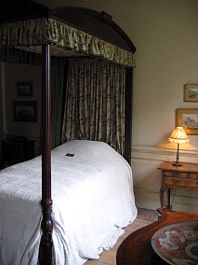
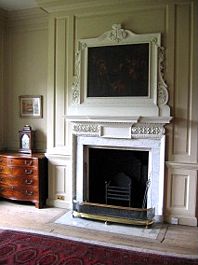
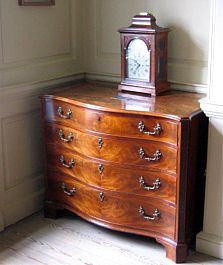
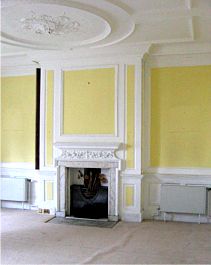
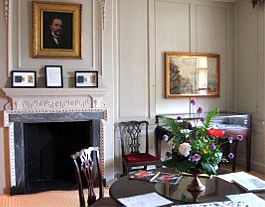 Another
of the principle bedrooms, this one at the front of the house is currently empty
and undergoing restoration. Even so, it shows the beautiful mouldings and plasterwork,
all of which is original to the eighteenth century. The Bedroom next to this one
at the front of the house is currently used as a Museum Room, housing display cabinets
of relevant family and house history items.
Another
of the principle bedrooms, this one at the front of the house is currently empty
and undergoing restoration. Even so, it shows the beautiful mouldings and plasterwork,
all of which is original to the eighteenth century. The Bedroom next to this one
at the front of the house is currently used as a Museum Room, housing display cabinets
of relevant family and house history items.
returning down the main staircase to the Hall, there is a staircase below the main staircase that leads down to the servant area, including the kitchen, cellars etc.
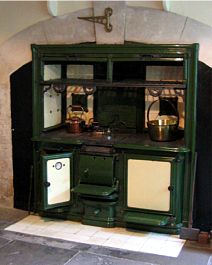
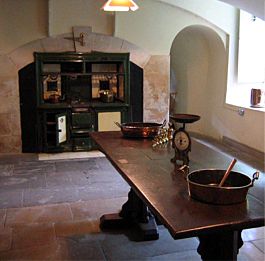
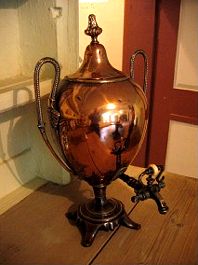
An old enamelled kitchen range is fitted into the chimney opening of the kitchen, I an sure quite modern in its day! On the kitchen dresser are a selection of copper moulds and also a nineteenth century copper tea urn.
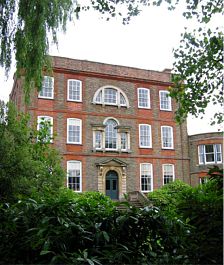
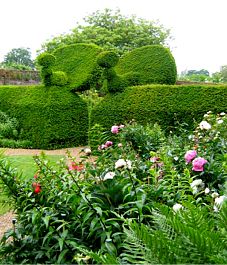
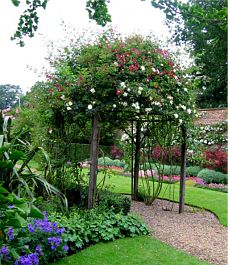
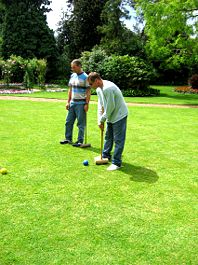 Returning
up the stairs to the hall and leaving by the back door of the house, one enters
a fabulous garden, beautifully kept and very large - quite unexpected. Indeed, the
garden stretches along the backs of other houses in the street and is filled with
the most delightful designs and planting. Old fashioned roses are trained up over
numerous arches and pergolas. There are large and colourful herbaceous borders,
rose and lavender gardens, ponds, clipped yew hedging, lawns, greenhouse and many
un-usual trees. On the main lawn behind the house it is set up with a croquet set,
with which visitors can play - a very nice touch. On this occasion I took the challenge
and had a round of croquet with my fellow visitors. This a perfect and enjoyable
way to admire the house and garden, whilst having a bit of fun!
Returning
up the stairs to the hall and leaving by the back door of the house, one enters
a fabulous garden, beautifully kept and very large - quite unexpected. Indeed, the
garden stretches along the backs of other houses in the street and is filled with
the most delightful designs and planting. Old fashioned roses are trained up over
numerous arches and pergolas. There are large and colourful herbaceous borders,
rose and lavender gardens, ponds, clipped yew hedging, lawns, greenhouse and many
un-usual trees. On the main lawn behind the house it is set up with a croquet set,
with which visitors can play - a very nice touch. On this occasion I took the challenge
and had a round of croquet with my fellow visitors. This a perfect and enjoyable
way to admire the house and garden, whilst having a bit of fun!
In a conservatory within the garden are some remarkably old Chinese orange trees, covered in fruit, the trees believed to be some 300 years old! They are recorded as being purchased at an auction by the Peckover's 200 years ago, and they were said to have been 100 years old when they bought them.
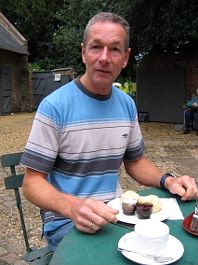 Tucked
in one corner of the gardens is a thatched barn, now housing a tea room. After a
game of Croquet what could be more enticing than to enjoy an afternoon tea outside
in the barns courtyard. On the menu was a 'Georgian' fruit cake (I don't believe
that it was original!) as well as a few other cakes, savouries and of course cream
teas. Having seen the scones just come out of the oven, freshly made there and still
hot, I plumped for the cream tea.
Tucked
in one corner of the gardens is a thatched barn, now housing a tea room. After a
game of Croquet what could be more enticing than to enjoy an afternoon tea outside
in the barns courtyard. On the menu was a 'Georgian' fruit cake (I don't believe
that it was original!) as well as a few other cakes, savouries and of course cream
teas. Having seen the scones just come out of the oven, freshly made there and still
hot, I plumped for the cream tea.
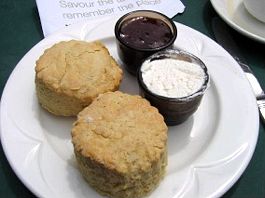 This
included the tea, two of the fresh scones, a little pot of jam and a pot of cream.
The scones were very good and could not have been any fresher, full marks for those.
However, in my opinion, the thing that rather let this tea down was the cream. This
should have a been clotted cream or at the very least a thickly whipped cream, but
what was served was anaemic, tasteless and full of air! I am not sure if that is
what the National Trust referred to when quoting on the paper napkins ' savour the
taste - remember the place'. However, this is a minor comment. Peckover House, its
gardens and friendly staff made this one of the nicest National Trust houses that
I think I have visited. I hope that you too find this the case, should you have
the chance to pay it a visit.
This
included the tea, two of the fresh scones, a little pot of jam and a pot of cream.
The scones were very good and could not have been any fresher, full marks for those.
However, in my opinion, the thing that rather let this tea down was the cream. This
should have a been clotted cream or at the very least a thickly whipped cream, but
what was served was anaemic, tasteless and full of air! I am not sure if that is
what the National Trust referred to when quoting on the paper napkins ' savour the
taste - remember the place'. However, this is a minor comment. Peckover House, its
gardens and friendly staff made this one of the nicest National Trust houses that
I think I have visited. I hope that you too find this the case, should you have
the chance to pay it a visit.
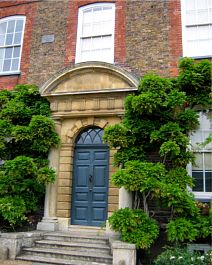 Peckover
House
Peckover
HouseClick here for
Local Map
Map courtesy of www.streetmap.co.uk
To review past newsletters, just follow this link:
Past newsletters.
To subscribe to this free newsletter -
Click here